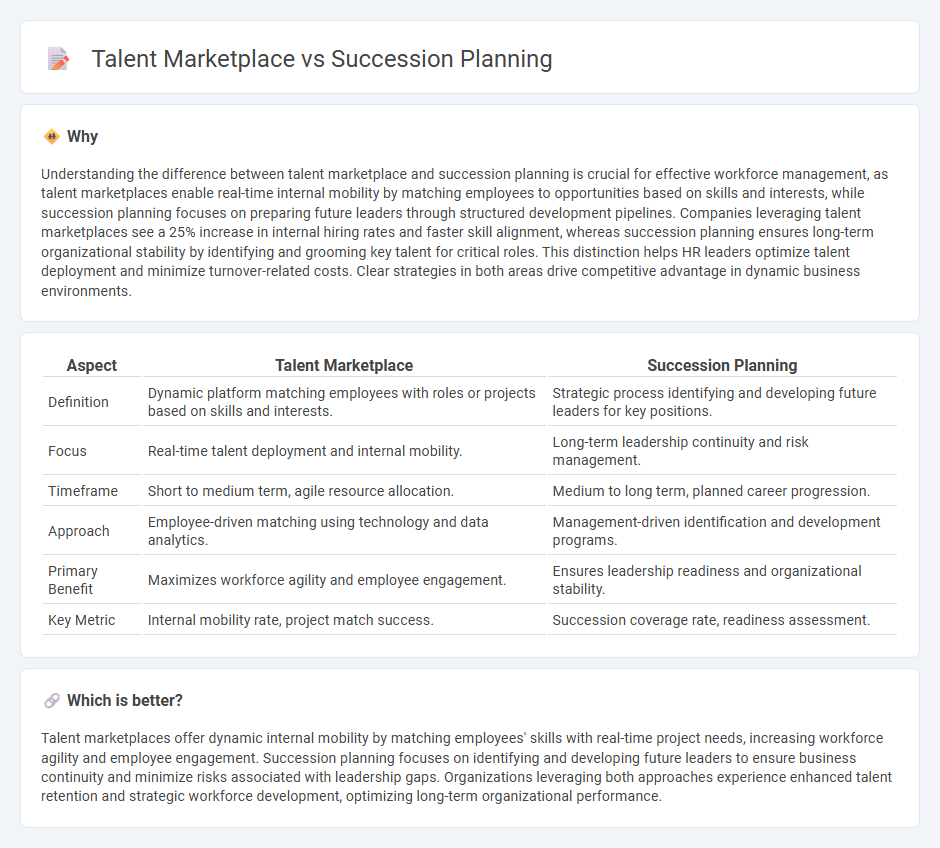
Talent marketplaces enable organizations to leverage internal talent by matching skills and projects through dynamic, technology-driven platforms, enhancing workforce agility and employee development. Succession planning focuses on identifying and preparing key individuals for critical leadership roles to ensure organizational continuity and long-term stability. Discover more about how these strategies transform talent management and drive business success.
Why it is important
Understanding the difference between talent marketplace and succession planning is crucial for effective workforce management, as talent marketplaces enable real-time internal mobility by matching employees to opportunities based on skills and interests, while succession planning focuses on preparing future leaders through structured development pipelines. Companies leveraging talent marketplaces see a 25% increase in internal hiring rates and faster skill alignment, whereas succession planning ensures long-term organizational stability by identifying and grooming key talent for critical roles. This distinction helps HR leaders optimize talent deployment and minimize turnover-related costs. Clear strategies in both areas drive competitive advantage in dynamic business environments.
Comparison Table
| Aspect | Talent Marketplace | Succession Planning |
|---|---|---|
| Definition | Dynamic platform matching employees with roles or projects based on skills and interests. | Strategic process identifying and developing future leaders for key positions. |
| Focus | Real-time talent deployment and internal mobility. | Long-term leadership continuity and risk management. |
| Timeframe | Short to medium term, agile resource allocation. | Medium to long term, planned career progression. |
| Approach | Employee-driven matching using technology and data analytics. | Management-driven identification and development programs. |
| Primary Benefit | Maximizes workforce agility and employee engagement. | Ensures leadership readiness and organizational stability. |
| Key Metric | Internal mobility rate, project match success. | Succession coverage rate, readiness assessment. |
Which is better?
Talent marketplaces offer dynamic internal mobility by matching employees' skills with real-time project needs, increasing workforce agility and employee engagement. Succession planning focuses on identifying and developing future leaders to ensure business continuity and minimize risks associated with leadership gaps. Organizations leveraging both approaches experience enhanced talent retention and strategic workforce development, optimizing long-term organizational performance.
Connection
Talent marketplaces enable organizations to identify and deploy internal skills efficiently, directly supporting succession planning by highlighting high-potential employees for future leadership roles. This dynamic approach to talent management ensures critical positions are filled with qualified candidates, reducing turnover risks and maintaining business continuity. Integrating talent marketplaces with succession planning optimizes workforce agility and strengthens leadership pipelines through data-driven insights.
Key Terms
**Succession Planning:**
Succession planning strategically identifies and develops internal candidates to fill key leadership roles, ensuring organizational continuity and minimizing talent gaps. It emphasizes a long-term approach by preparing high-potential employees through targeted training and mentorship programs. Explore how succession planning can secure your company's future leadership needs effectively.
Leadership Pipeline
Succession planning strategically identifies and develops future leaders within an organization to ensure a robust leadership pipeline, while talent marketplaces dynamically match internal talent to leadership opportunities based on real-time skills and experiences. Leadership pipeline development benefits from the stability of succession plans and the agility of talent marketplaces, fostering continuous growth and readiness in leadership roles. Explore how combining these approaches transforms leadership development in your organization.
Critical Roles
Succession planning targets the identification and development of internal candidates to fill critical roles, ensuring leadership continuity and minimizing operational disruptions. Talent marketplaces leverage a dynamic platform to match employees' skills with critical role opportunities, promoting agility and internal mobility. Explore how integrating both approaches can optimize workforce strategy for key positions.
Source and External Links
Succession Planning: All You Need To Know [2025 Edition] - Succession planning is the process of selecting and developing key talent to ensure continuity of critical roles by identifying key positions, assessing current talent, and preparing successors through leadership development programs.
Succession Planning: 7-Step Guide & Template - Succession planning is a long-term strategy to identify and train employees to replace key roles, ensuring smooth transitions, business continuity, and improved employee retention and diversity.
Succession planning - Succession planning is a process for identifying and developing internal personnel with leadership potential to fill critical roles when they become vacant, commonly used in business and family firms to ensure leadership continuity and smooth transitions.
 dowidth.com
dowidth.com